Medina
Created By: Sandy An, Melanie Gaston, and Jacob Wolfarth.
Where is Medina?

Map of Saudi Arabia
by Christopher Rose, used under 
The city of Medina is located in present day Saudi Arabia. It is in the North-West quadrant of the country near the Red Sea. Mecca is approximately 270 miles south of Medina. Back in 622 AD when Muhammad first traveled to Medina, which is known as the Hijah, Medina actually had the name of Yathrib. It has continued to be known as the second holiest city in Saudi Arabia ever since Saudi Arabia became a country on January 8, 1926. Saudi Arabia is located within the Arabian Peninsula. The peninsula is surrounded by three bodies of water, which are the Persian Gulf, the Red Sea, and the Arabian Sea. The national language of Saudi Arabia and all other countries within the Arabian Peninsula is Arabic. Obviously Arabic has a strong connection to Islam because it is the language in which the Koran is normally written.
Medina
Medina, originally Yathrib, is known to the Muslims as al-Madīnah al-Munawwarah. The name Medina, “city,” comes from Madinat Al-Nabi, meaning “The City of the Prophet” (Nomachi, 1997).
In 622 AD, Muhammad, the Blessed Prophet’s migrated to Medina and marked the beginning of the Islamic calendar and the establishment of the first Islamic community and the first mosque.
Along with Mecca, Medina is one of the two holiest centers of Islam. As a result of its holiness, entrance to the sacred core of Medina (but not the entire city) is restricted to Muslims only; non-Muslims are permitted neither to enter nor cross through the city center (Medina, 2013).
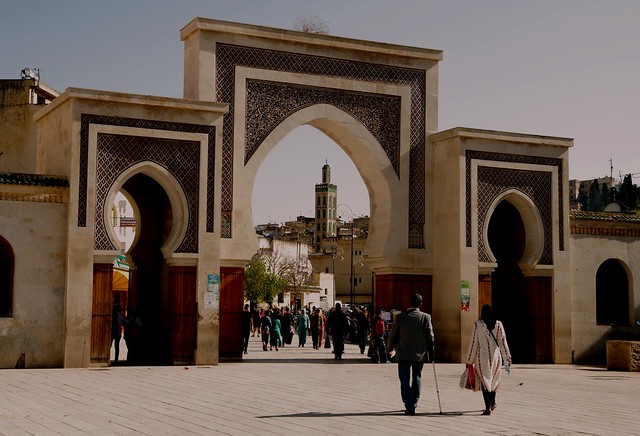
Main Entrance of Medina
by Danijel Jozić, used under 
In the historical context, Arabs were divided into tribal branches throughout the Arabian peninsula. For example, the Abil was a branch of the Amaliq. The Abil founded the city of Yathrib. Yathrib became a prosperous community due to its fertile land, which was full of underground water. However, its inhabitants’ disobedience of God resulted in disasters such as pestilence and outside intrusions (Nomachi, 1997).
The Life of the Prophet in Medina
The Prophet Muhammad was born in Mecca into the Hashemite clan of the Quraysh tribe. Muhammad was expelled from the tribe once he began preaching Islam and monotheism. He endured several attacks and punishments from the Quraysh and later fled to Medina for refuge (Nomachi, 1997).
Against the Quraysh, the first great battle was al-Badr. This battle marked a turning point in the Prophet’s struggles against the powerful enemy, the Quraysh.
The next battle, the battle of Uhud, the Prophet and the Muslims were defeated.

Site of the Battle of Uhud
by Omar A., used under 
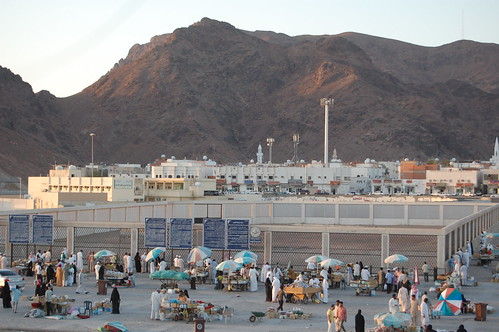
Cemetery of the martyrs at the site of the Battle of Uhud
by Omar A., used under 

Mountain of Uhud
by Belal Khan, used under 
In the battle of Khaybar or the Battle of the Trench, a trench was dug around Medina for protection with the aid of the Prophet.
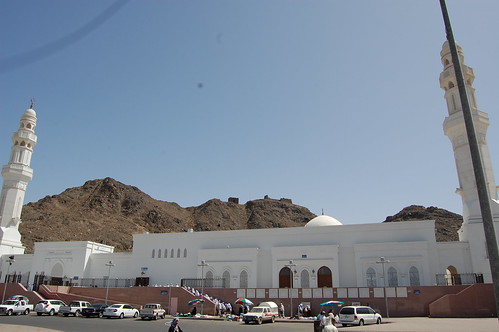
Site of the Battle of the Trench
by Omar A., used under 
The Prophet prepared a Constitution and established laws for future Islamic practice, including the foundations to the Islamic Law or al-Shari ah. Under the Prophet’s influence and guidance, Medina became the foundation model for all later Islamic societies (Nomachi, 1997).
The Prophet spent the rest of his life in Mecca after founding the Islamic civilization.
The Mosques in Medina
Medina contains the three oldest mosques in Islamic history: the Mosque of the Prophet, the Quba Mosque, and the Mosque of the Two Qiblas.
The Quba Mosque is located at the site where Muhammad performed his prayers.

Quba Mosque
by Chris Helmkamp, used under 
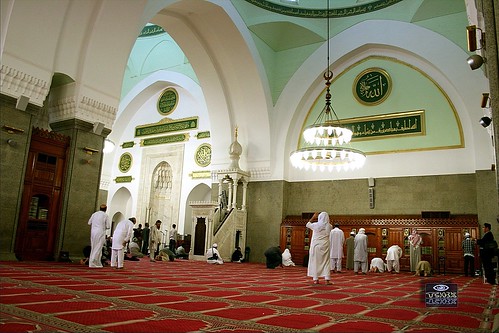
Quba Mosque interior
by Hossam all line, used under 
Another famous mosque in Medina is the Masjid al-Qiblatain (Arabic: المسجد القبلتین ) “Mosque of the two Qiblas.” The name of the mosque derives from an event that took place during Muhammad’s time. According to historical records, Muhammad was leading the prayer when he received a revelation from Allah instructing him to take the Kaaba as the Qiblah. According to traditional accounts, Muhammad, who had been facing Jerusalem during the prayer, upon receiving this revelation, immediately turned around to face Mecca, and those praying behind him also did so. After this, the mosque in which this incident occurred came to be known as Masjid al-Qiblatain, “Mosque of the Two Qiblas” (Nomachi, 1997).

Masjid al-Qiblatain, “The Mosque of the Two Qiblas”
UmmSqueakyPhotographer Name, used under 
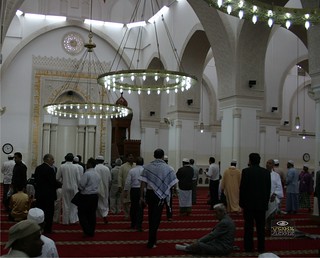
Interior of the Masjid al-Qiblatain
Hossam all line 
In 632 AD, the Prophet Muhammad died and was buried in Medina in his apartment next to the future Mosque of the Prophet. Al-Masjid al-Nabawi (Arabic: المسجد النبوي ) “Mosque of the Prophet”, often called the Prophet’s Mosque, is a mosque situated in the city of Medina as the final resting place of the Prophet Muhammad.The site property was Muhammad’s original settlement after his Hijra (emigration) to Medina. He himself shared in the heavy work of construction. The original mosque was an open-air building. The basic plan of the building has been adopted in the building of other mosques throughout the world.The Mosque of the Prophet and Muhammad’s tomb are both located in Medina, along with other significant religious landmarks (Nomachi, 1997).

Masjid-al-Nabawi at dusk
by Fraz Ismat 
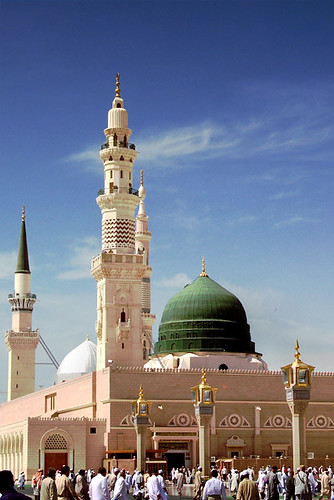
The Green Dome of the Mosque of the Prophet
by Shabbir Siraj, used under 

Umbrellas at Al-Masjid al-Nabawi, the Mosque of the Prophet
by Basheer Olakara, used under 
Click Here to take a virtual tour of the Prophet’s Mosque and learn about its history!
Medina in Later Islamic History
The first three caliphs, Abu Bakr, Umar, and Uthman, ruled the Islamic civilization from Medina. They expanded the boundaries of Medina and enlarged the Mosque of the Prophet (Nomachi, 1997).
The Hajj
The annual pilgrimage occurs during the last month of the Islamic year, called Dhu’l-hijjah, meaning “The Month of hajj.” The pilgrimage rites occur during a 5 day period, between the 8th – 12th days of this lunar month. During the hajj, Muslims from all over the world are united once a year in both Mecca and Medina.

Pilgrims leaving Masjid-al-Nabawi
by Fraz Ismat, used under 
The Holy City Today
“The hajj serves as a spiritual rejuvenation and a renewal of the Islamic pre-eternal covenant with God” (Nomachi, 1997). It remains a powerful way of realizing the Unity of God and the interrelation of all of His creation. Hence, Mecca and Medina both flourish as the heat and sacred center of the Islamic universe.
Click Here to experience modern day Medina!
What Makes A Holy City Holy?
Medina is known as the second holiest city in Saudi Arabia, but what does this mean? What makes a city holy? A city is considered holy to a specific religion when important events take place and/or an influential person who is significant within the religion has made a profound impact on that city. Muhammad, who is the most significant person in Islam, made huge impacts on Medina that are further discussed on this page. The importance of Medina to Muslims is made apparent by the fact that non-Muslims may not enter the core of Medina. The privilege to enter is held only by Muslims.
Click on Here to see a comprehensive map of Medina and its architectural locations!
References:
Bautista, J. (2010, April 14). Medina – المدينة المنورة, Saudi Arabia [Video file]. Retrieved from http://www.youtube.com/watch?feature=player_embedded&v=VuEKW_IajGU
Nomachi, K., & Nasr, S. H. (1997). Mecca the blessed, Medina the radiant: The holiest cities of Islam. New York: Aperture.
Medina. (2013). In Encyclopaedia Britannica. Retrieved from http://www.britannica.com/EBchecked/topic/372565/Medina
(2013). Medina Things to Do. virtualtourist.com. Retrieved November 20, from http://www.virtualtourist.com/travel/Middle_East/Saudi_Arabia/Mintaqat_al_Madinah/Medina-1807665/Things_To_Do-Medina-TG-C-1.html.
(2013). Medina Map. sacred-destinations.com. Retrieved November 20, from http://www.sacred-destinations.com/saudi-arabia/medina-map.
(2013, December). Prophet’s Mosque. 3dmekanlar.com. Retrieved November 15, from http://www.3dmekanlar.com/en/prophets-mosque.html.
***Updated December 2013***
